Analysis of Health Workforce Immigration Policies in Australia
VerifiedAdded on 2023/04/21
|12
|2537
|341
Report
AI Summary
This report evaluates Australia's reliance on international health worker immigration to meet workforce supply, examining current Australian policies and their historical development. It assesses the sustainability of these policies and proposes changes to overcome negative impacts, such as the over-reliance on foreign workers and the maldistribution of health professionals. The report highlights the need for effective health workforce planning, including demographic trend analysis and scenario planning, to ensure quality healthcare delivery and address challenges related to workforce self-sufficiency and cost management. The document concludes that Australia needs to implement health workforce reforms that can help regulate the immigration of health workforce to overcome the prevailing issues. Desklib provides a platform for students to access this and other solved assignments.
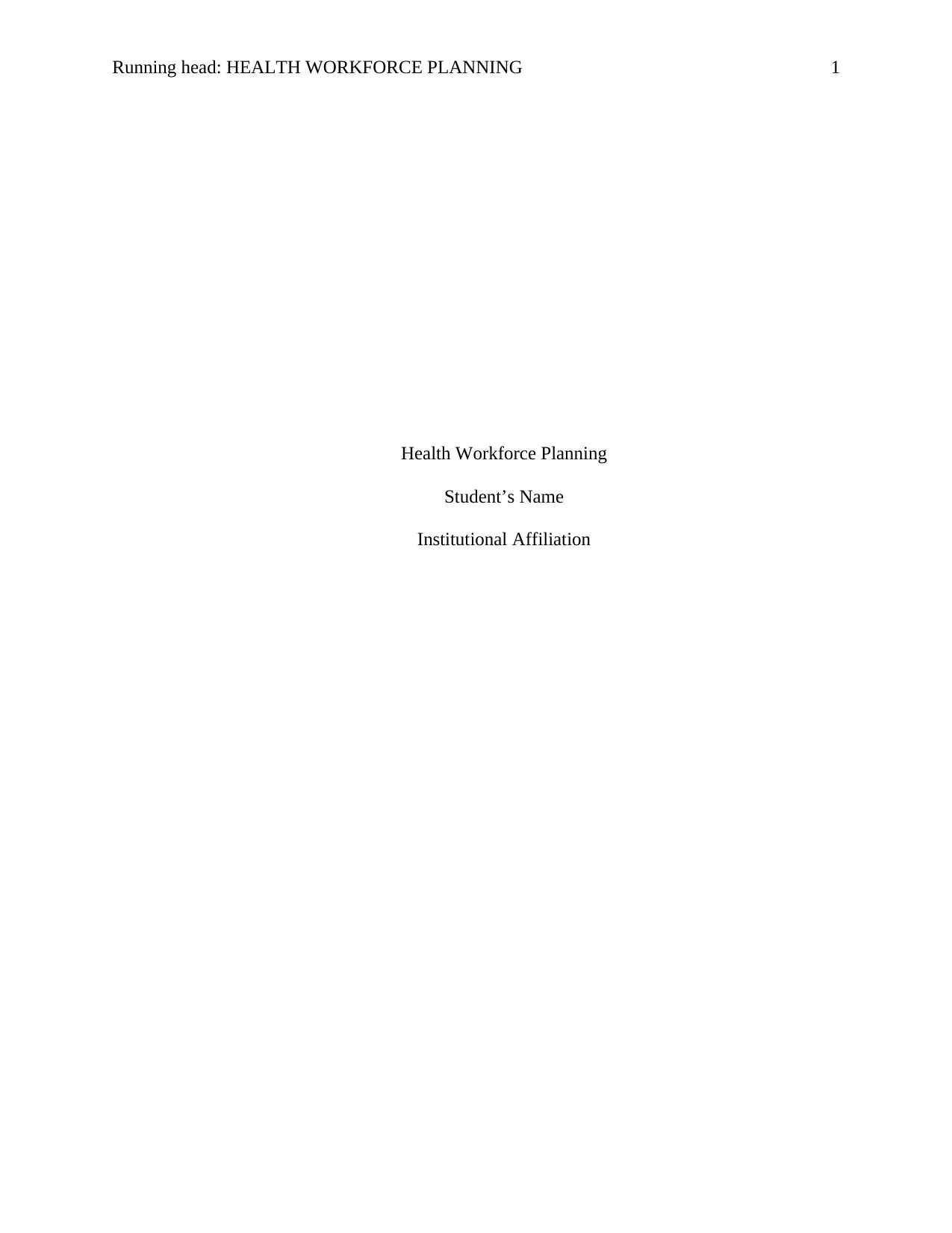
Running head: HEALTH WORKFORCE PLANNING 1
Health Workforce Planning
Student’s Name
Institutional Affiliation
Health Workforce Planning
Student’s Name
Institutional Affiliation
Paraphrase This Document
Need a fresh take? Get an instant paraphrase of this document with our AI Paraphraser
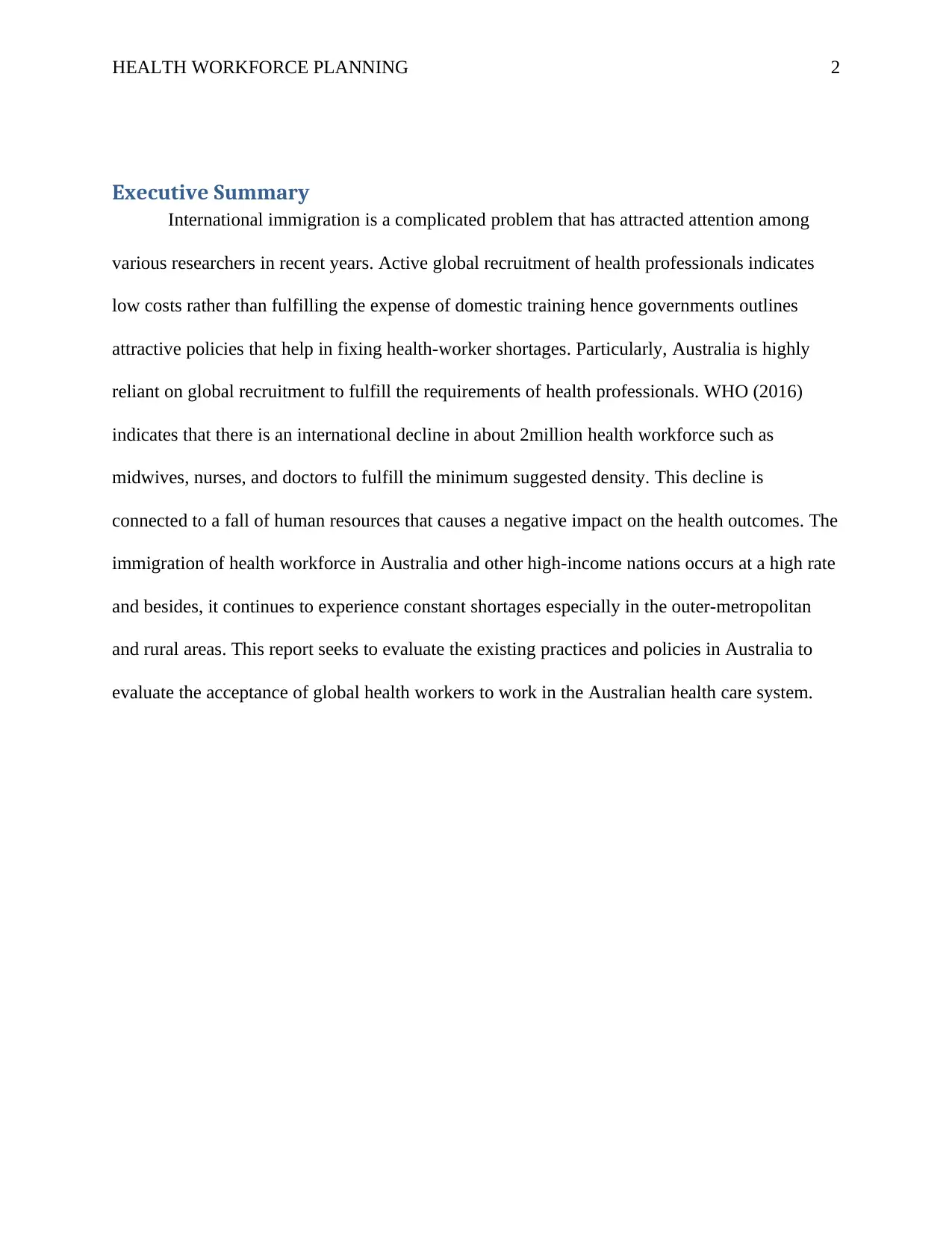
HEALTH WORKFORCE PLANNING 2
Executive Summary
International immigration is a complicated problem that has attracted attention among
various researchers in recent years. Active global recruitment of health professionals indicates
low costs rather than fulfilling the expense of domestic training hence governments outlines
attractive policies that help in fixing health-worker shortages. Particularly, Australia is highly
reliant on global recruitment to fulfill the requirements of health professionals. WHO (2016)
indicates that there is an international decline in about 2million health workforce such as
midwives, nurses, and doctors to fulfill the minimum suggested density. This decline is
connected to a fall of human resources that causes a negative impact on the health outcomes. The
immigration of health workforce in Australia and other high-income nations occurs at a high rate
and besides, it continues to experience constant shortages especially in the outer-metropolitan
and rural areas. This report seeks to evaluate the existing practices and policies in Australia to
evaluate the acceptance of global health workers to work in the Australian health care system.
Executive Summary
International immigration is a complicated problem that has attracted attention among
various researchers in recent years. Active global recruitment of health professionals indicates
low costs rather than fulfilling the expense of domestic training hence governments outlines
attractive policies that help in fixing health-worker shortages. Particularly, Australia is highly
reliant on global recruitment to fulfill the requirements of health professionals. WHO (2016)
indicates that there is an international decline in about 2million health workforce such as
midwives, nurses, and doctors to fulfill the minimum suggested density. This decline is
connected to a fall of human resources that causes a negative impact on the health outcomes. The
immigration of health workforce in Australia and other high-income nations occurs at a high rate
and besides, it continues to experience constant shortages especially in the outer-metropolitan
and rural areas. This report seeks to evaluate the existing practices and policies in Australia to
evaluate the acceptance of global health workers to work in the Australian health care system.
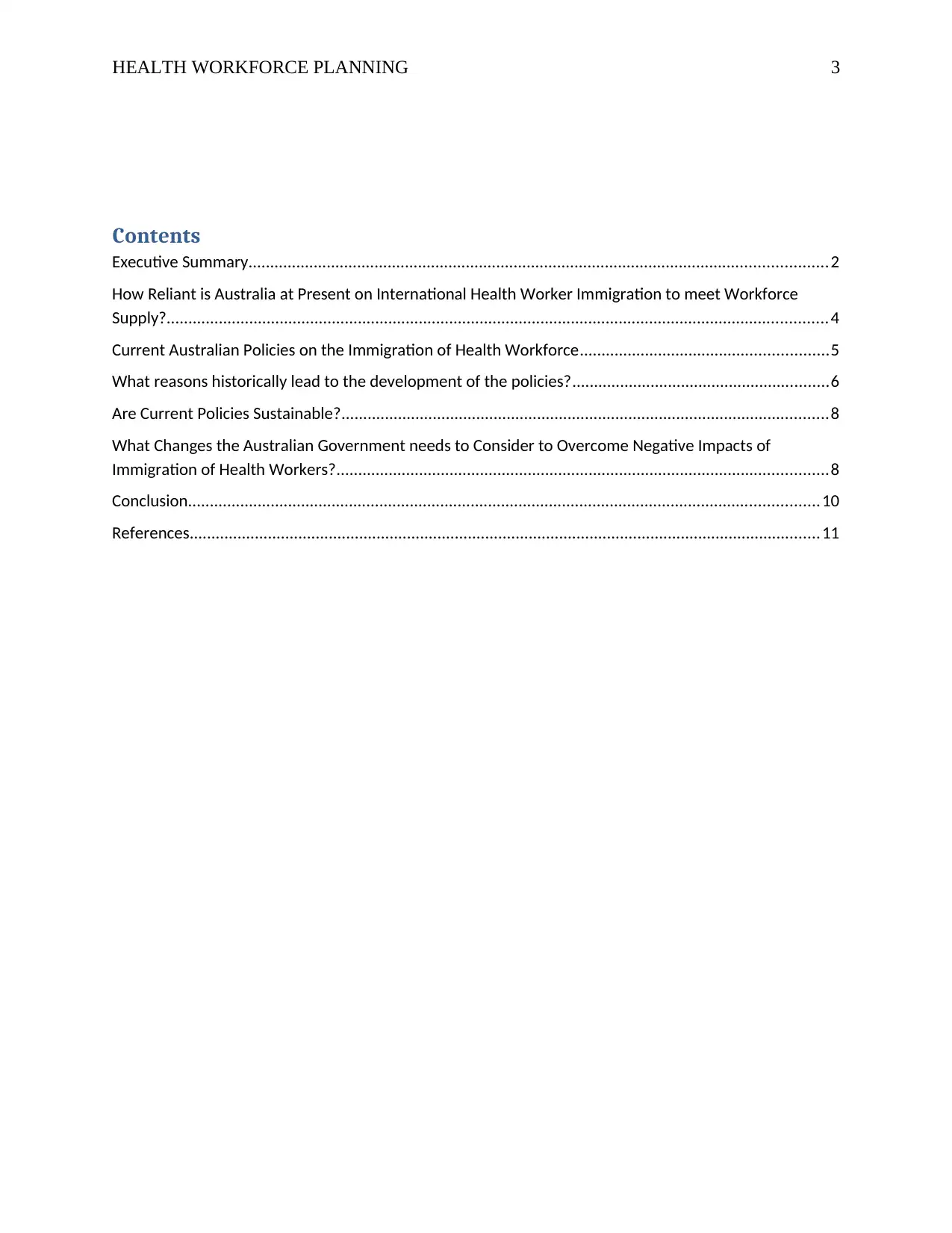
HEALTH WORKFORCE PLANNING 3
Contents
Executive Summary.....................................................................................................................................2
How Reliant is Australia at Present on International Health Worker Immigration to meet Workforce
Supply?........................................................................................................................................................4
Current Australian Policies on the Immigration of Health Workforce.........................................................5
What reasons historically lead to the development of the policies?...........................................................6
Are Current Policies Sustainable?................................................................................................................8
What Changes the Australian Government needs to Consider to Overcome Negative Impacts of
Immigration of Health Workers?.................................................................................................................8
Conclusion.................................................................................................................................................10
References.................................................................................................................................................11
Contents
Executive Summary.....................................................................................................................................2
How Reliant is Australia at Present on International Health Worker Immigration to meet Workforce
Supply?........................................................................................................................................................4
Current Australian Policies on the Immigration of Health Workforce.........................................................5
What reasons historically lead to the development of the policies?...........................................................6
Are Current Policies Sustainable?................................................................................................................8
What Changes the Australian Government needs to Consider to Overcome Negative Impacts of
Immigration of Health Workers?.................................................................................................................8
Conclusion.................................................................................................................................................10
References.................................................................................................................................................11
⊘ This is a preview!⊘
Do you want full access?
Subscribe today to unlock all pages.

Trusted by 1+ million students worldwide
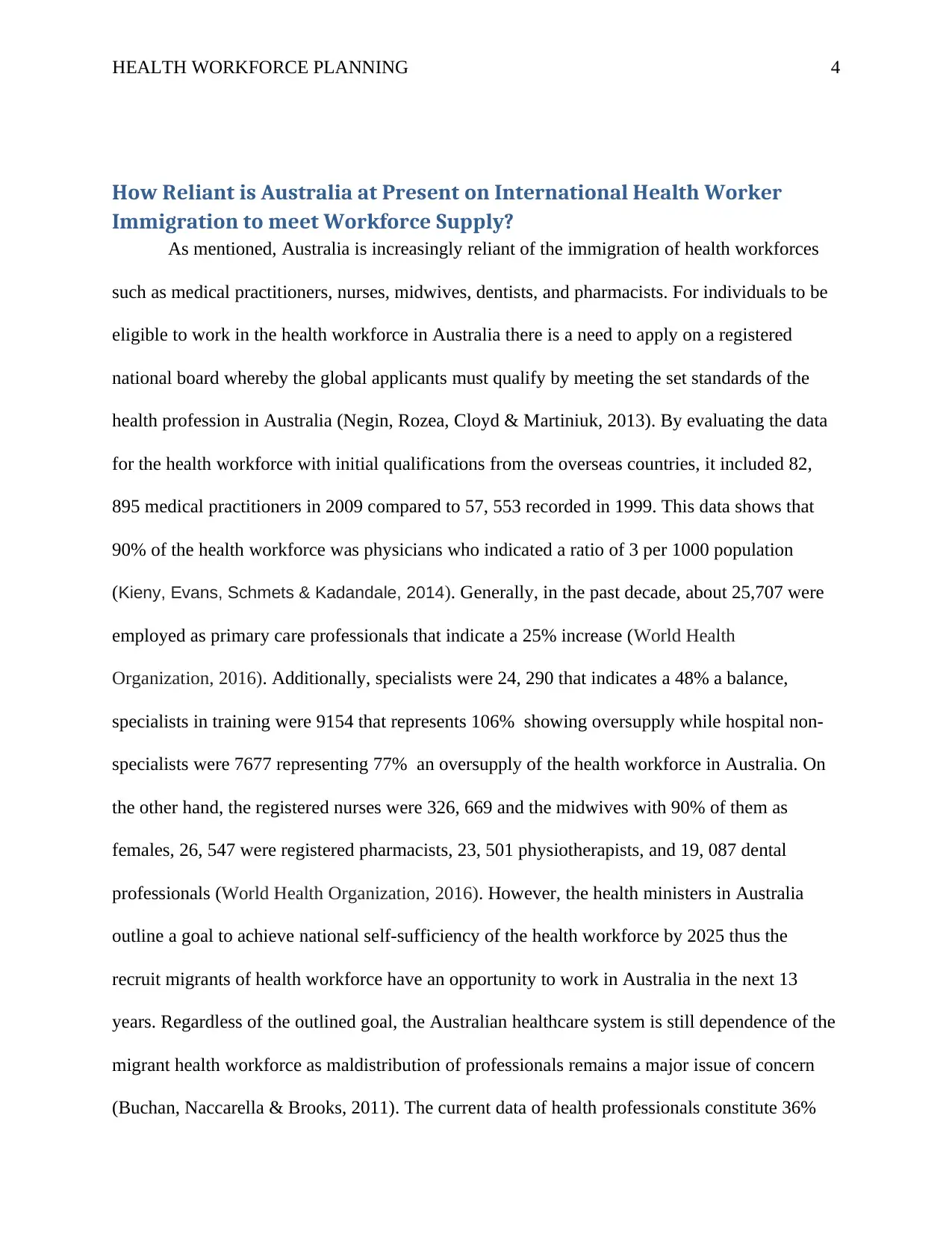
HEALTH WORKFORCE PLANNING 4
How Reliant is Australia at Present on International Health Worker
Immigration to meet Workforce Supply?
As mentioned, Australia is increasingly reliant of the immigration of health workforces
such as medical practitioners, nurses, midwives, dentists, and pharmacists. For individuals to be
eligible to work in the health workforce in Australia there is a need to apply on a registered
national board whereby the global applicants must qualify by meeting the set standards of the
health profession in Australia (Negin, Rozea, Cloyd & Martiniuk, 2013). By evaluating the data
for the health workforce with initial qualifications from the overseas countries, it included 82,
895 medical practitioners in 2009 compared to 57, 553 recorded in 1999. This data shows that
90% of the health workforce was physicians who indicated a ratio of 3 per 1000 population
(Kieny, Evans, Schmets & Kadandale, 2014). Generally, in the past decade, about 25,707 were
employed as primary care professionals that indicate a 25% increase (World Health
Organization, 2016). Additionally, specialists were 24, 290 that indicates a 48% a balance,
specialists in training were 9154 that represents 106% showing oversupply while hospital non-
specialists were 7677 representing 77% an oversupply of the health workforce in Australia. On
the other hand, the registered nurses were 326, 669 and the midwives with 90% of them as
females, 26, 547 were registered pharmacists, 23, 501 physiotherapists, and 19, 087 dental
professionals (World Health Organization, 2016). However, the health ministers in Australia
outline a goal to achieve national self-sufficiency of the health workforce by 2025 thus the
recruit migrants of health workforce have an opportunity to work in Australia in the next 13
years. Regardless of the outlined goal, the Australian healthcare system is still dependence of the
migrant health workforce as maldistribution of professionals remains a major issue of concern
(Buchan, Naccarella & Brooks, 2011). The current data of health professionals constitute 36%
How Reliant is Australia at Present on International Health Worker
Immigration to meet Workforce Supply?
As mentioned, Australia is increasingly reliant of the immigration of health workforces
such as medical practitioners, nurses, midwives, dentists, and pharmacists. For individuals to be
eligible to work in the health workforce in Australia there is a need to apply on a registered
national board whereby the global applicants must qualify by meeting the set standards of the
health profession in Australia (Negin, Rozea, Cloyd & Martiniuk, 2013). By evaluating the data
for the health workforce with initial qualifications from the overseas countries, it included 82,
895 medical practitioners in 2009 compared to 57, 553 recorded in 1999. This data shows that
90% of the health workforce was physicians who indicated a ratio of 3 per 1000 population
(Kieny, Evans, Schmets & Kadandale, 2014). Generally, in the past decade, about 25,707 were
employed as primary care professionals that indicate a 25% increase (World Health
Organization, 2016). Additionally, specialists were 24, 290 that indicates a 48% a balance,
specialists in training were 9154 that represents 106% showing oversupply while hospital non-
specialists were 7677 representing 77% an oversupply of the health workforce in Australia. On
the other hand, the registered nurses were 326, 669 and the midwives with 90% of them as
females, 26, 547 were registered pharmacists, 23, 501 physiotherapists, and 19, 087 dental
professionals (World Health Organization, 2016). However, the health ministers in Australia
outline a goal to achieve national self-sufficiency of the health workforce by 2025 thus the
recruit migrants of health workforce have an opportunity to work in Australia in the next 13
years. Regardless of the outlined goal, the Australian healthcare system is still dependence of the
migrant health workforce as maldistribution of professionals remains a major issue of concern
(Buchan, Naccarella & Brooks, 2011). The current data of health professionals constitute 36%
Paraphrase This Document
Need a fresh take? Get an instant paraphrase of this document with our AI Paraphraser
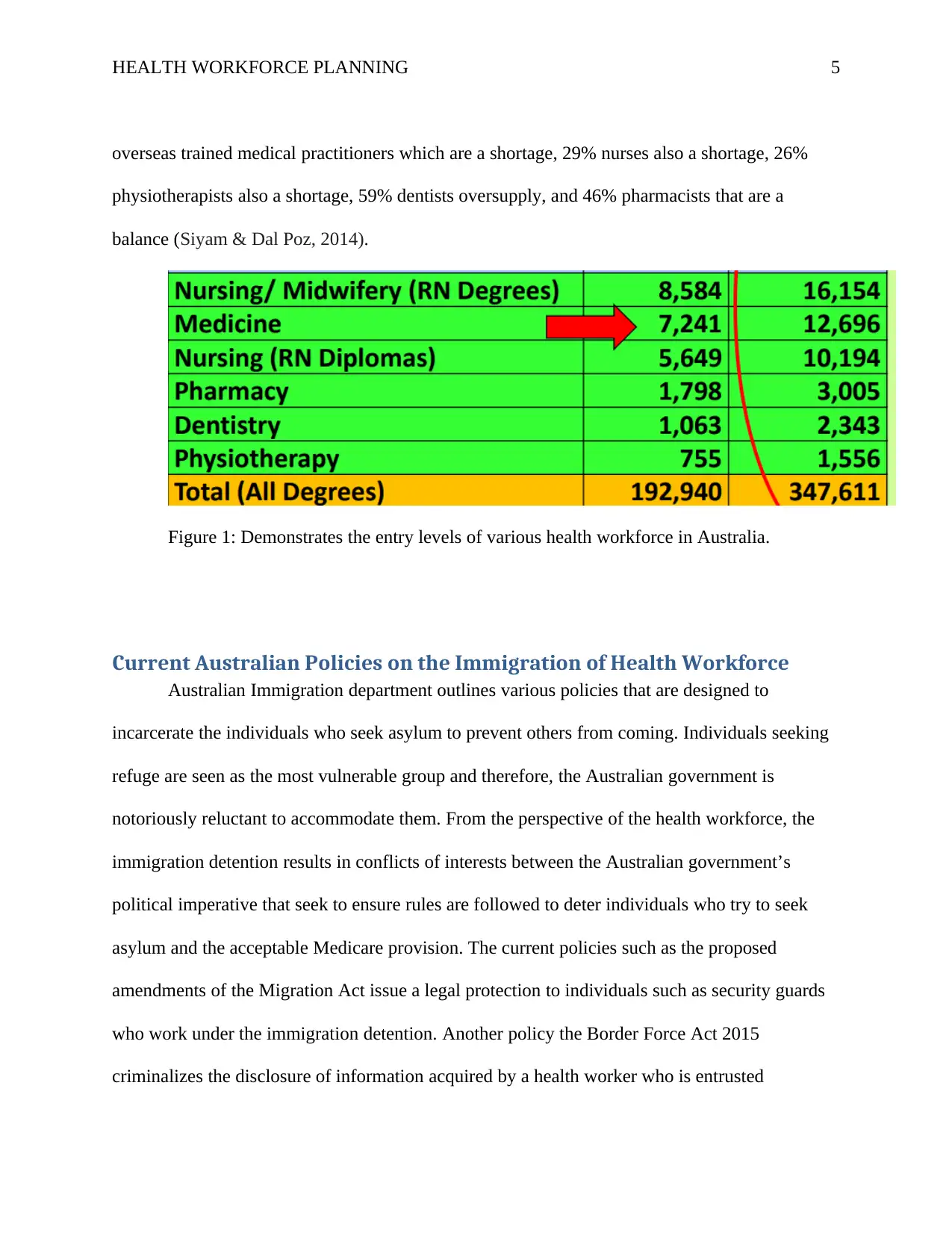
HEALTH WORKFORCE PLANNING 5
overseas trained medical practitioners which are a shortage, 29% nurses also a shortage, 26%
physiotherapists also a shortage, 59% dentists oversupply, and 46% pharmacists that are a
balance (Siyam & Dal Poz, 2014).
Figure 1: Demonstrates the entry levels of various health workforce in Australia.
Current Australian Policies on the Immigration of Health Workforce
Australian Immigration department outlines various policies that are designed to
incarcerate the individuals who seek asylum to prevent others from coming. Individuals seeking
refuge are seen as the most vulnerable group and therefore, the Australian government is
notoriously reluctant to accommodate them. From the perspective of the health workforce, the
immigration detention results in conflicts of interests between the Australian government’s
political imperative that seek to ensure rules are followed to deter individuals who try to seek
asylum and the acceptable Medicare provision. The current policies such as the proposed
amendments of the Migration Act issue a legal protection to individuals such as security guards
who work under the immigration detention. Another policy the Border Force Act 2015
criminalizes the disclosure of information acquired by a health worker who is entrusted
overseas trained medical practitioners which are a shortage, 29% nurses also a shortage, 26%
physiotherapists also a shortage, 59% dentists oversupply, and 46% pharmacists that are a
balance (Siyam & Dal Poz, 2014).
Figure 1: Demonstrates the entry levels of various health workforce in Australia.
Current Australian Policies on the Immigration of Health Workforce
Australian Immigration department outlines various policies that are designed to
incarcerate the individuals who seek asylum to prevent others from coming. Individuals seeking
refuge are seen as the most vulnerable group and therefore, the Australian government is
notoriously reluctant to accommodate them. From the perspective of the health workforce, the
immigration detention results in conflicts of interests between the Australian government’s
political imperative that seek to ensure rules are followed to deter individuals who try to seek
asylum and the acceptable Medicare provision. The current policies such as the proposed
amendments of the Migration Act issue a legal protection to individuals such as security guards
who work under the immigration detention. Another policy the Border Force Act 2015
criminalizes the disclosure of information acquired by a health worker who is entrusted
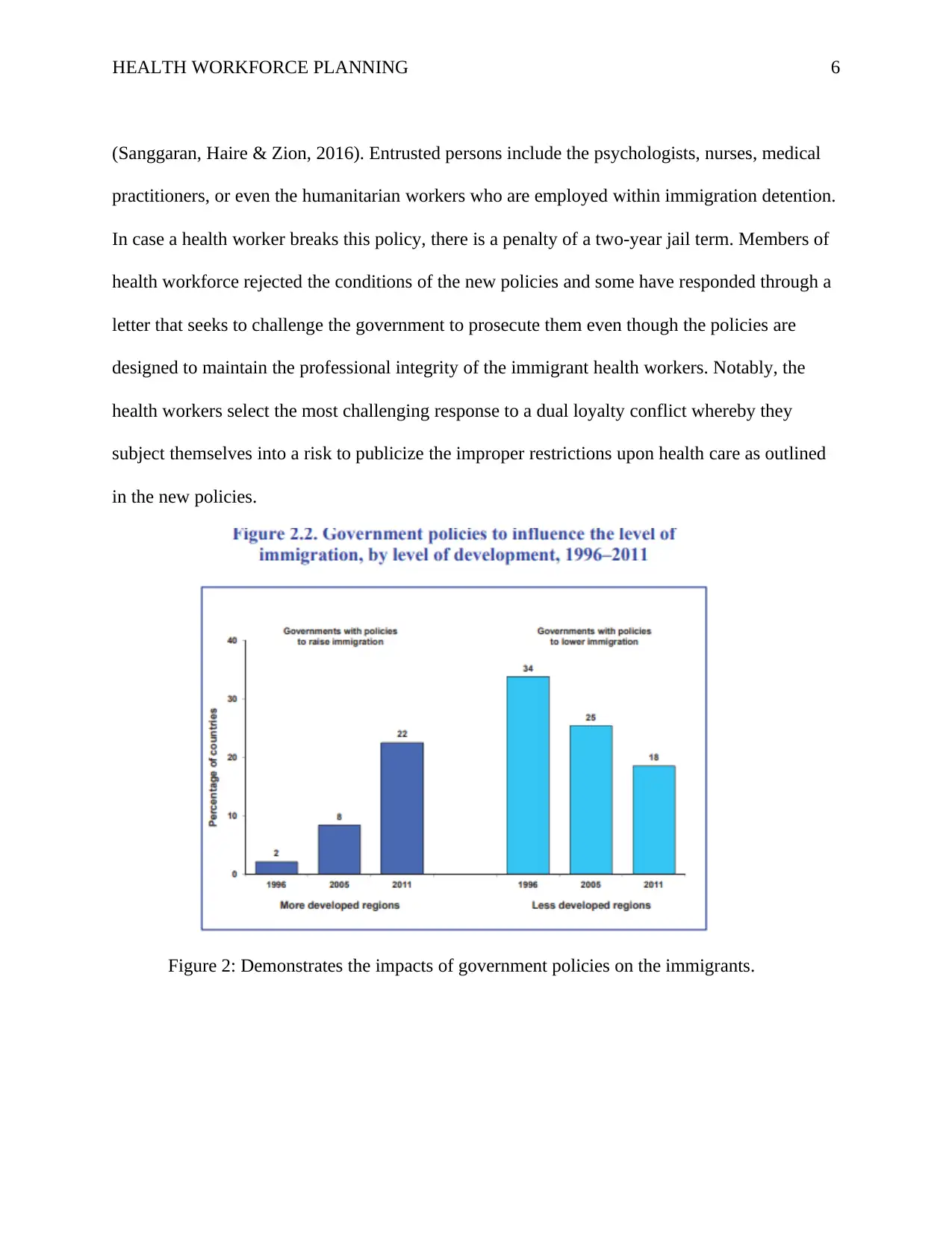
HEALTH WORKFORCE PLANNING 6
(Sanggaran, Haire & Zion, 2016). Entrusted persons include the psychologists, nurses, medical
practitioners, or even the humanitarian workers who are employed within immigration detention.
In case a health worker breaks this policy, there is a penalty of a two-year jail term. Members of
health workforce rejected the conditions of the new policies and some have responded through a
letter that seeks to challenge the government to prosecute them even though the policies are
designed to maintain the professional integrity of the immigrant health workers. Notably, the
health workers select the most challenging response to a dual loyalty conflict whereby they
subject themselves into a risk to publicize the improper restrictions upon health care as outlined
in the new policies.
Figure 2: Demonstrates the impacts of government policies on the immigrants.
(Sanggaran, Haire & Zion, 2016). Entrusted persons include the psychologists, nurses, medical
practitioners, or even the humanitarian workers who are employed within immigration detention.
In case a health worker breaks this policy, there is a penalty of a two-year jail term. Members of
health workforce rejected the conditions of the new policies and some have responded through a
letter that seeks to challenge the government to prosecute them even though the policies are
designed to maintain the professional integrity of the immigrant health workers. Notably, the
health workers select the most challenging response to a dual loyalty conflict whereby they
subject themselves into a risk to publicize the improper restrictions upon health care as outlined
in the new policies.
Figure 2: Demonstrates the impacts of government policies on the immigrants.
⊘ This is a preview!⊘
Do you want full access?
Subscribe today to unlock all pages.

Trusted by 1+ million students worldwide
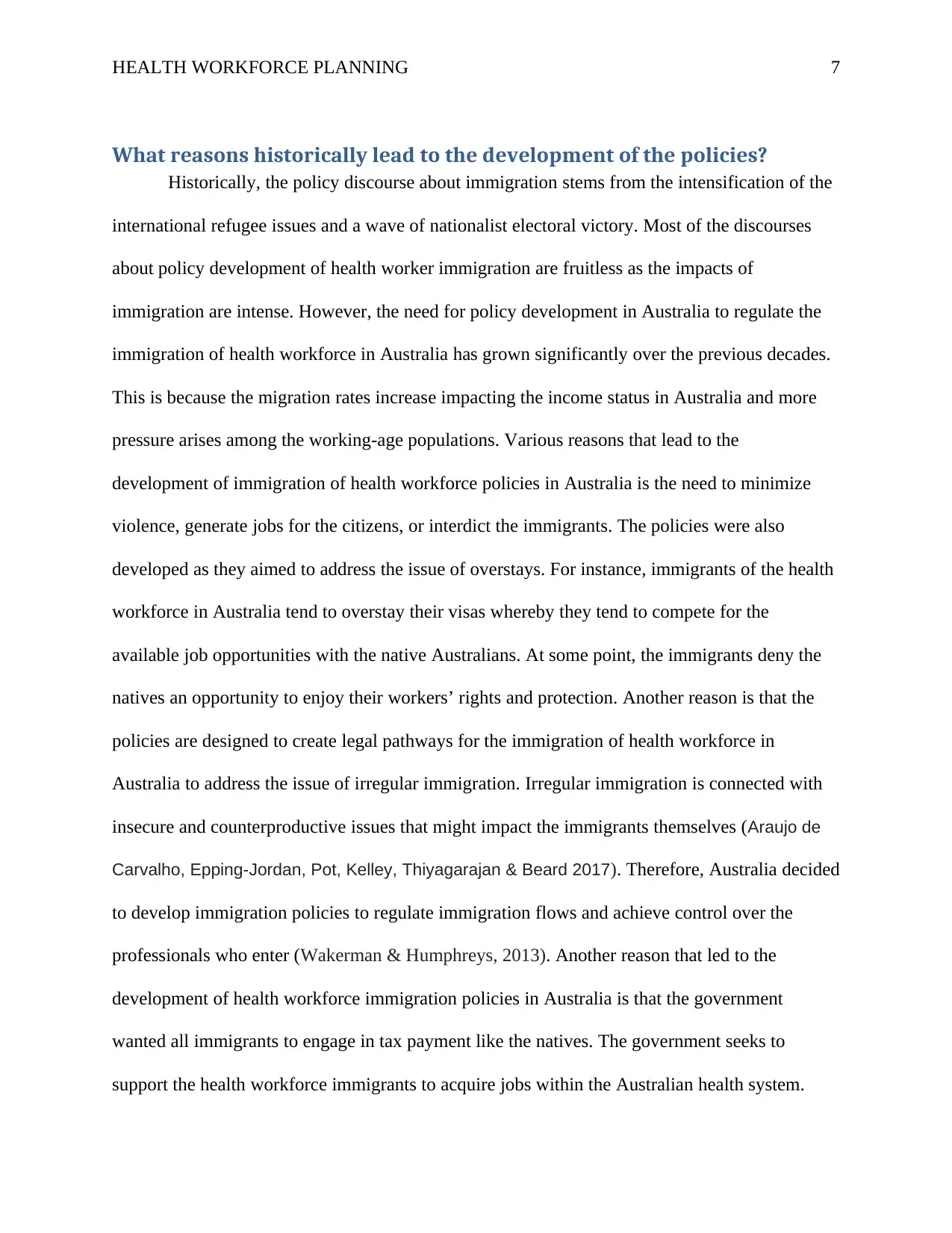
HEALTH WORKFORCE PLANNING 7
What reasons historically lead to the development of the policies?
Historically, the policy discourse about immigration stems from the intensification of the
international refugee issues and a wave of nationalist electoral victory. Most of the discourses
about policy development of health worker immigration are fruitless as the impacts of
immigration are intense. However, the need for policy development in Australia to regulate the
immigration of health workforce in Australia has grown significantly over the previous decades.
This is because the migration rates increase impacting the income status in Australia and more
pressure arises among the working-age populations. Various reasons that lead to the
development of immigration of health workforce policies in Australia is the need to minimize
violence, generate jobs for the citizens, or interdict the immigrants. The policies were also
developed as they aimed to address the issue of overstays. For instance, immigrants of the health
workforce in Australia tend to overstay their visas whereby they tend to compete for the
available job opportunities with the native Australians. At some point, the immigrants deny the
natives an opportunity to enjoy their workers’ rights and protection. Another reason is that the
policies are designed to create legal pathways for the immigration of health workforce in
Australia to address the issue of irregular immigration. Irregular immigration is connected with
insecure and counterproductive issues that might impact the immigrants themselves (Araujo de
Carvalho, Epping-Jordan, Pot, Kelley, Thiyagarajan & Beard 2017). Therefore, Australia decided
to develop immigration policies to regulate immigration flows and achieve control over the
professionals who enter (Wakerman & Humphreys, 2013). Another reason that led to the
development of health workforce immigration policies in Australia is that the government
wanted all immigrants to engage in tax payment like the natives. The government seeks to
support the health workforce immigrants to acquire jobs within the Australian health system.
What reasons historically lead to the development of the policies?
Historically, the policy discourse about immigration stems from the intensification of the
international refugee issues and a wave of nationalist electoral victory. Most of the discourses
about policy development of health worker immigration are fruitless as the impacts of
immigration are intense. However, the need for policy development in Australia to regulate the
immigration of health workforce in Australia has grown significantly over the previous decades.
This is because the migration rates increase impacting the income status in Australia and more
pressure arises among the working-age populations. Various reasons that lead to the
development of immigration of health workforce policies in Australia is the need to minimize
violence, generate jobs for the citizens, or interdict the immigrants. The policies were also
developed as they aimed to address the issue of overstays. For instance, immigrants of the health
workforce in Australia tend to overstay their visas whereby they tend to compete for the
available job opportunities with the native Australians. At some point, the immigrants deny the
natives an opportunity to enjoy their workers’ rights and protection. Another reason is that the
policies are designed to create legal pathways for the immigration of health workforce in
Australia to address the issue of irregular immigration. Irregular immigration is connected with
insecure and counterproductive issues that might impact the immigrants themselves (Araujo de
Carvalho, Epping-Jordan, Pot, Kelley, Thiyagarajan & Beard 2017). Therefore, Australia decided
to develop immigration policies to regulate immigration flows and achieve control over the
professionals who enter (Wakerman & Humphreys, 2013). Another reason that led to the
development of health workforce immigration policies in Australia is that the government
wanted all immigrants to engage in tax payment like the natives. The government seeks to
support the health workforce immigrants to acquire jobs within the Australian health system.
Paraphrase This Document
Need a fresh take? Get an instant paraphrase of this document with our AI Paraphraser
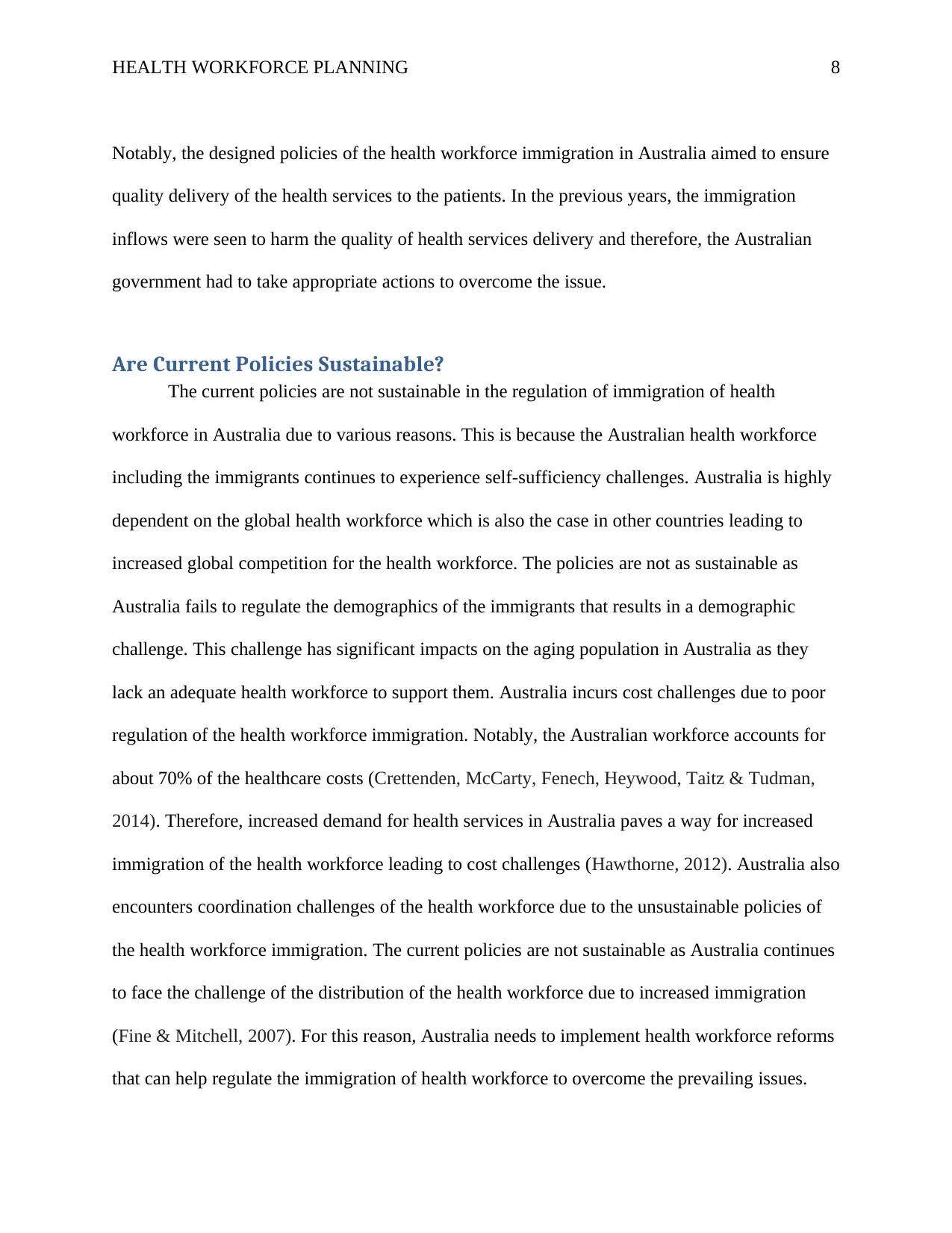
HEALTH WORKFORCE PLANNING 8
Notably, the designed policies of the health workforce immigration in Australia aimed to ensure
quality delivery of the health services to the patients. In the previous years, the immigration
inflows were seen to harm the quality of health services delivery and therefore, the Australian
government had to take appropriate actions to overcome the issue.
Are Current Policies Sustainable?
The current policies are not sustainable in the regulation of immigration of health
workforce in Australia due to various reasons. This is because the Australian health workforce
including the immigrants continues to experience self-sufficiency challenges. Australia is highly
dependent on the global health workforce which is also the case in other countries leading to
increased global competition for the health workforce. The policies are not as sustainable as
Australia fails to regulate the demographics of the immigrants that results in a demographic
challenge. This challenge has significant impacts on the aging population in Australia as they
lack an adequate health workforce to support them. Australia incurs cost challenges due to poor
regulation of the health workforce immigration. Notably, the Australian workforce accounts for
about 70% of the healthcare costs (Crettenden, McCarty, Fenech, Heywood, Taitz & Tudman,
2014). Therefore, increased demand for health services in Australia paves a way for increased
immigration of the health workforce leading to cost challenges (Hawthorne, 2012). Australia also
encounters coordination challenges of the health workforce due to the unsustainable policies of
the health workforce immigration. The current policies are not sustainable as Australia continues
to face the challenge of the distribution of the health workforce due to increased immigration
(Fine & Mitchell, 2007). For this reason, Australia needs to implement health workforce reforms
that can help regulate the immigration of health workforce to overcome the prevailing issues.
Notably, the designed policies of the health workforce immigration in Australia aimed to ensure
quality delivery of the health services to the patients. In the previous years, the immigration
inflows were seen to harm the quality of health services delivery and therefore, the Australian
government had to take appropriate actions to overcome the issue.
Are Current Policies Sustainable?
The current policies are not sustainable in the regulation of immigration of health
workforce in Australia due to various reasons. This is because the Australian health workforce
including the immigrants continues to experience self-sufficiency challenges. Australia is highly
dependent on the global health workforce which is also the case in other countries leading to
increased global competition for the health workforce. The policies are not as sustainable as
Australia fails to regulate the demographics of the immigrants that results in a demographic
challenge. This challenge has significant impacts on the aging population in Australia as they
lack an adequate health workforce to support them. Australia incurs cost challenges due to poor
regulation of the health workforce immigration. Notably, the Australian workforce accounts for
about 70% of the healthcare costs (Crettenden, McCarty, Fenech, Heywood, Taitz & Tudman,
2014). Therefore, increased demand for health services in Australia paves a way for increased
immigration of the health workforce leading to cost challenges (Hawthorne, 2012). Australia also
encounters coordination challenges of the health workforce due to the unsustainable policies of
the health workforce immigration. The current policies are not sustainable as Australia continues
to face the challenge of the distribution of the health workforce due to increased immigration
(Fine & Mitchell, 2007). For this reason, Australia needs to implement health workforce reforms
that can help regulate the immigration of health workforce to overcome the prevailing issues.
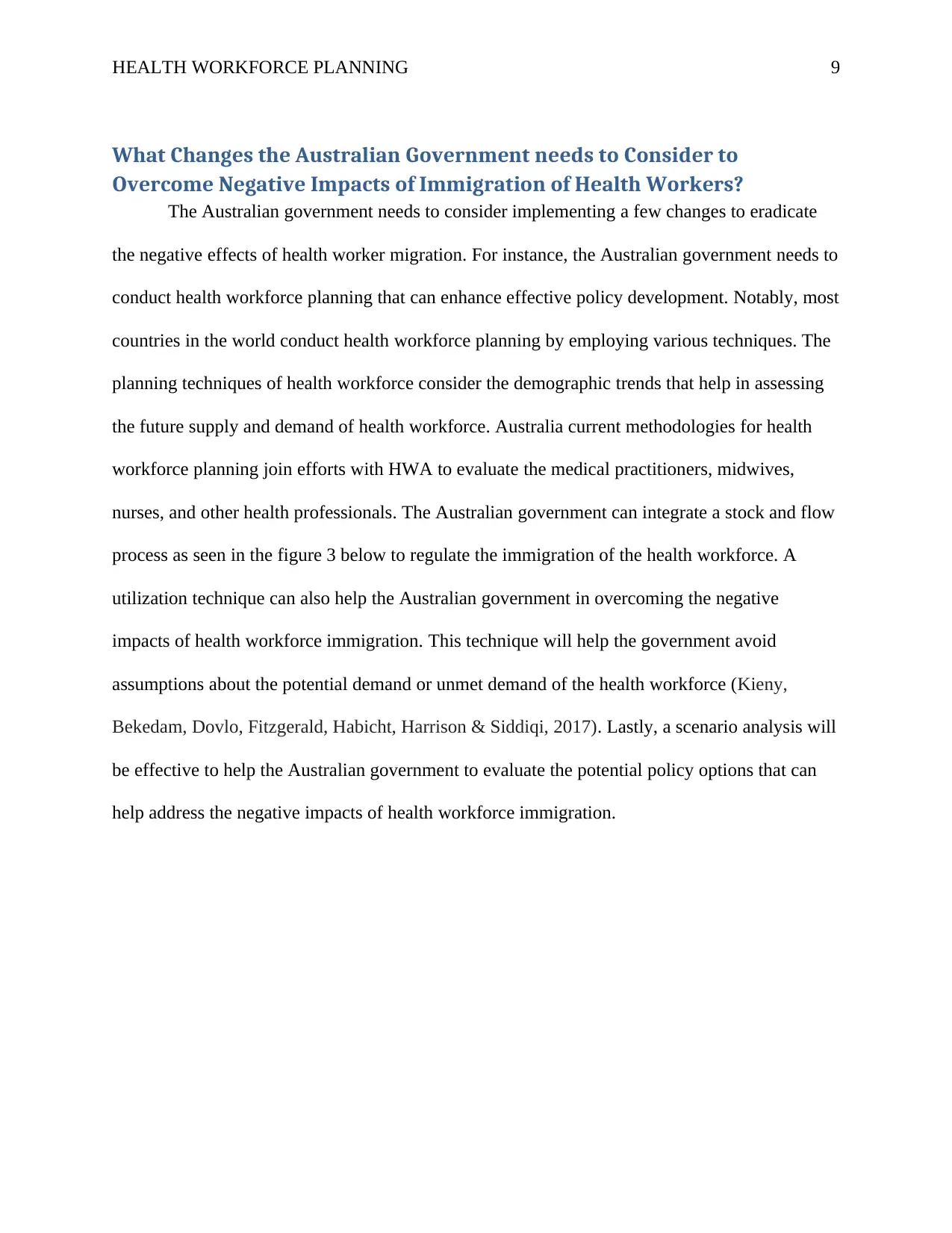
HEALTH WORKFORCE PLANNING 9
What Changes the Australian Government needs to Consider to
Overcome Negative Impacts of Immigration of Health Workers?
The Australian government needs to consider implementing a few changes to eradicate
the negative effects of health worker migration. For instance, the Australian government needs to
conduct health workforce planning that can enhance effective policy development. Notably, most
countries in the world conduct health workforce planning by employing various techniques. The
planning techniques of health workforce consider the demographic trends that help in assessing
the future supply and demand of health workforce. Australia current methodologies for health
workforce planning join efforts with HWA to evaluate the medical practitioners, midwives,
nurses, and other health professionals. The Australian government can integrate a stock and flow
process as seen in the figure 3 below to regulate the immigration of the health workforce. A
utilization technique can also help the Australian government in overcoming the negative
impacts of health workforce immigration. This technique will help the government avoid
assumptions about the potential demand or unmet demand of the health workforce (Kieny,
Bekedam, Dovlo, Fitzgerald, Habicht, Harrison & Siddiqi, 2017). Lastly, a scenario analysis will
be effective to help the Australian government to evaluate the potential policy options that can
help address the negative impacts of health workforce immigration.
What Changes the Australian Government needs to Consider to
Overcome Negative Impacts of Immigration of Health Workers?
The Australian government needs to consider implementing a few changes to eradicate
the negative effects of health worker migration. For instance, the Australian government needs to
conduct health workforce planning that can enhance effective policy development. Notably, most
countries in the world conduct health workforce planning by employing various techniques. The
planning techniques of health workforce consider the demographic trends that help in assessing
the future supply and demand of health workforce. Australia current methodologies for health
workforce planning join efforts with HWA to evaluate the medical practitioners, midwives,
nurses, and other health professionals. The Australian government can integrate a stock and flow
process as seen in the figure 3 below to regulate the immigration of the health workforce. A
utilization technique can also help the Australian government in overcoming the negative
impacts of health workforce immigration. This technique will help the government avoid
assumptions about the potential demand or unmet demand of the health workforce (Kieny,
Bekedam, Dovlo, Fitzgerald, Habicht, Harrison & Siddiqi, 2017). Lastly, a scenario analysis will
be effective to help the Australian government to evaluate the potential policy options that can
help address the negative impacts of health workforce immigration.
⊘ This is a preview!⊘
Do you want full access?
Subscribe today to unlock all pages.

Trusted by 1+ million students worldwide
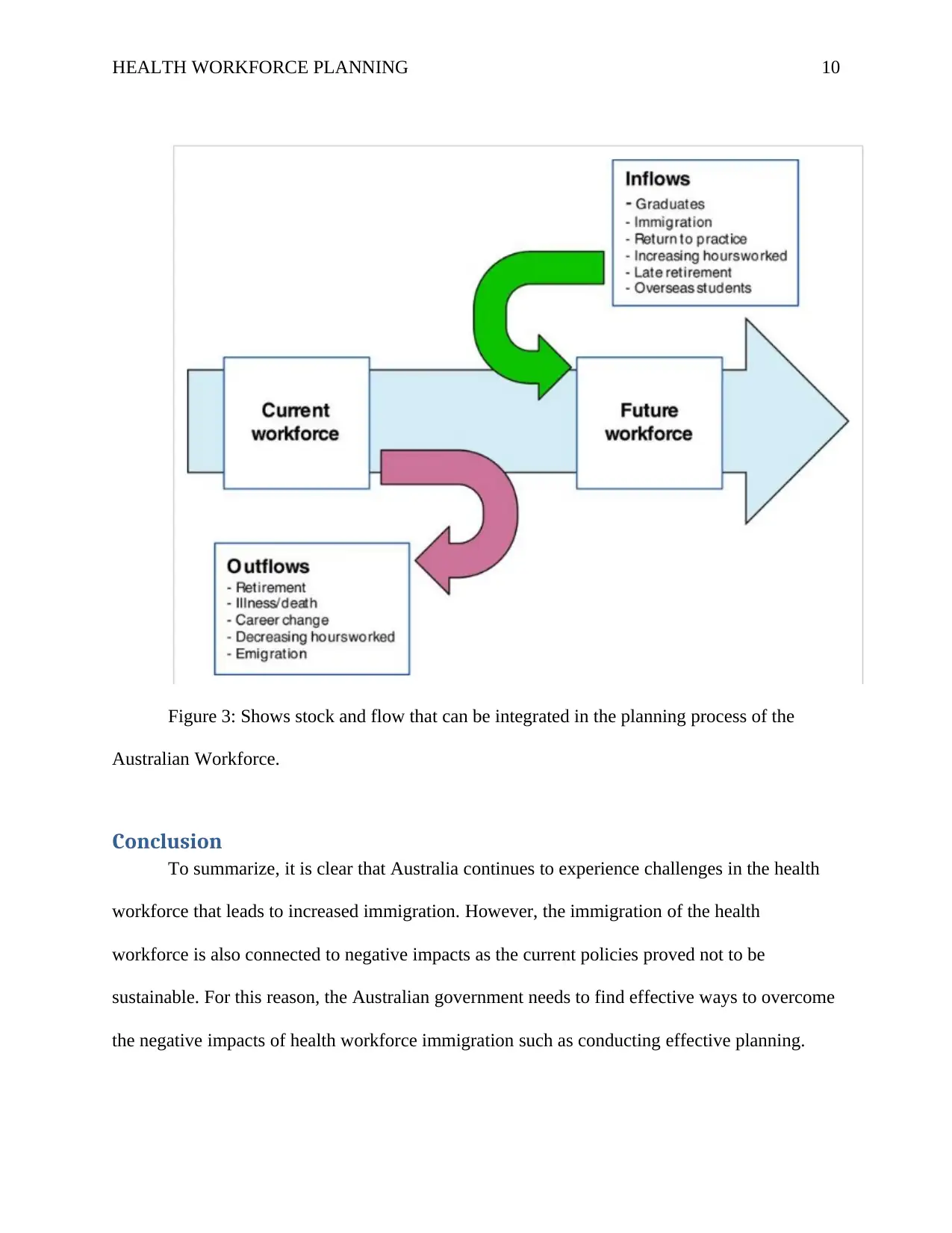
HEALTH WORKFORCE PLANNING 10
Figure 3: Shows stock and flow that can be integrated in the planning process of the
Australian Workforce.
Conclusion
To summarize, it is clear that Australia continues to experience challenges in the health
workforce that leads to increased immigration. However, the immigration of the health
workforce is also connected to negative impacts as the current policies proved not to be
sustainable. For this reason, the Australian government needs to find effective ways to overcome
the negative impacts of health workforce immigration such as conducting effective planning.
Figure 3: Shows stock and flow that can be integrated in the planning process of the
Australian Workforce.
Conclusion
To summarize, it is clear that Australia continues to experience challenges in the health
workforce that leads to increased immigration. However, the immigration of the health
workforce is also connected to negative impacts as the current policies proved not to be
sustainable. For this reason, the Australian government needs to find effective ways to overcome
the negative impacts of health workforce immigration such as conducting effective planning.
Paraphrase This Document
Need a fresh take? Get an instant paraphrase of this document with our AI Paraphraser
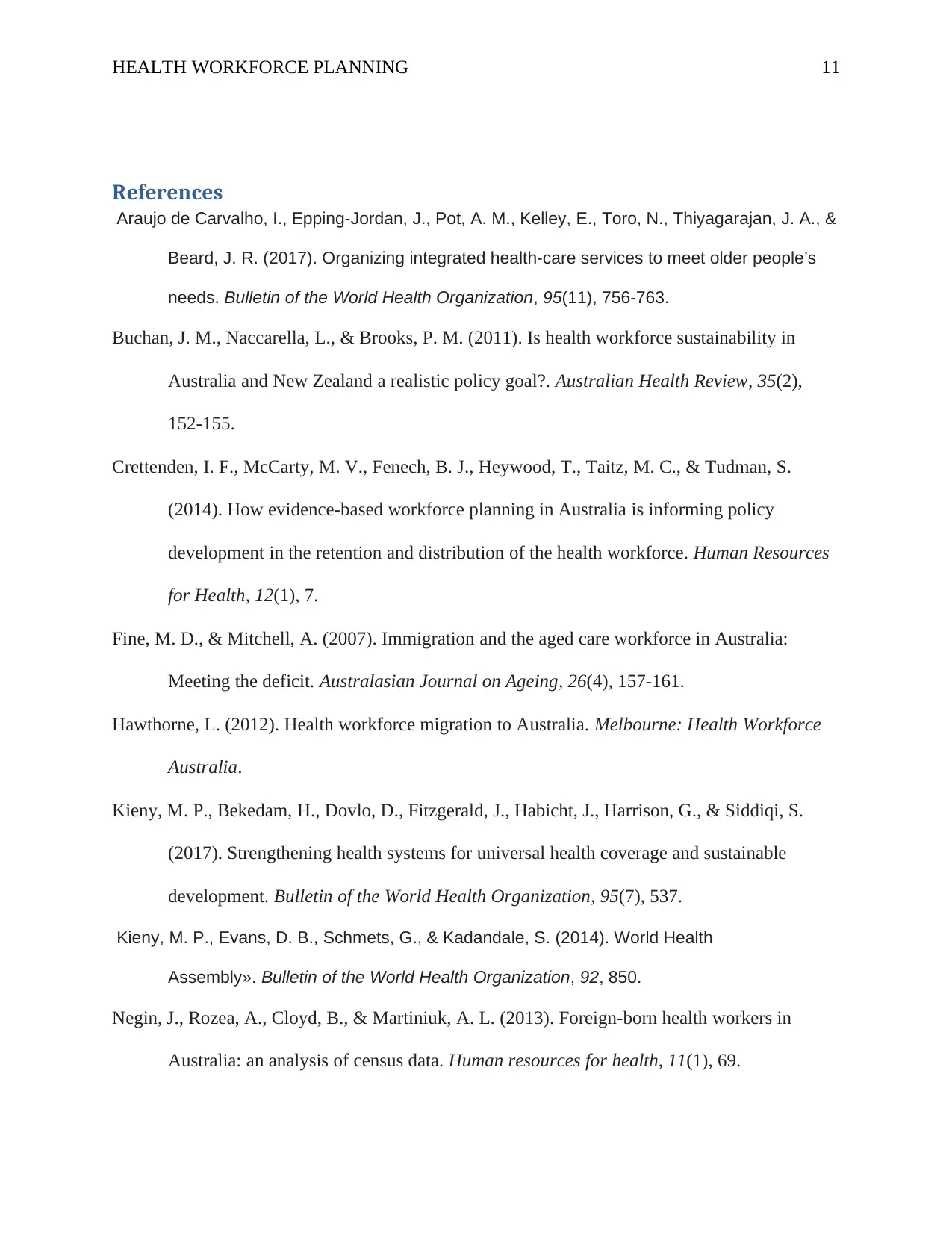
HEALTH WORKFORCE PLANNING 11
References
Araujo de Carvalho, I., Epping-Jordan, J., Pot, A. M., Kelley, E., Toro, N., Thiyagarajan, J. A., &
Beard, J. R. (2017). Organizing integrated health-care services to meet older people’s
needs. Bulletin of the World Health Organization, 95(11), 756-763.
Buchan, J. M., Naccarella, L., & Brooks, P. M. (2011). Is health workforce sustainability in
Australia and New Zealand a realistic policy goal?. Australian Health Review, 35(2),
152-155.
Crettenden, I. F., McCarty, M. V., Fenech, B. J., Heywood, T., Taitz, M. C., & Tudman, S.
(2014). How evidence-based workforce planning in Australia is informing policy
development in the retention and distribution of the health workforce. Human Resources
for Health, 12(1), 7.
Fine, M. D., & Mitchell, A. (2007). Immigration and the aged care workforce in Australia:
Meeting the deficit. Australasian Journal on Ageing, 26(4), 157-161.
Hawthorne, L. (2012). Health workforce migration to Australia. Melbourne: Health Workforce
Australia.
Kieny, M. P., Bekedam, H., Dovlo, D., Fitzgerald, J., Habicht, J., Harrison, G., & Siddiqi, S.
(2017). Strengthening health systems for universal health coverage and sustainable
development. Bulletin of the World Health Organization, 95(7), 537.
Kieny, M. P., Evans, D. B., Schmets, G., & Kadandale, S. (2014). World Health
Assembly». Bulletin of the World Health Organization, 92, 850.
Negin, J., Rozea, A., Cloyd, B., & Martiniuk, A. L. (2013). Foreign-born health workers in
Australia: an analysis of census data. Human resources for health, 11(1), 69.
References
Araujo de Carvalho, I., Epping-Jordan, J., Pot, A. M., Kelley, E., Toro, N., Thiyagarajan, J. A., &
Beard, J. R. (2017). Organizing integrated health-care services to meet older people’s
needs. Bulletin of the World Health Organization, 95(11), 756-763.
Buchan, J. M., Naccarella, L., & Brooks, P. M. (2011). Is health workforce sustainability in
Australia and New Zealand a realistic policy goal?. Australian Health Review, 35(2),
152-155.
Crettenden, I. F., McCarty, M. V., Fenech, B. J., Heywood, T., Taitz, M. C., & Tudman, S.
(2014). How evidence-based workforce planning in Australia is informing policy
development in the retention and distribution of the health workforce. Human Resources
for Health, 12(1), 7.
Fine, M. D., & Mitchell, A. (2007). Immigration and the aged care workforce in Australia:
Meeting the deficit. Australasian Journal on Ageing, 26(4), 157-161.
Hawthorne, L. (2012). Health workforce migration to Australia. Melbourne: Health Workforce
Australia.
Kieny, M. P., Bekedam, H., Dovlo, D., Fitzgerald, J., Habicht, J., Harrison, G., & Siddiqi, S.
(2017). Strengthening health systems for universal health coverage and sustainable
development. Bulletin of the World Health Organization, 95(7), 537.
Kieny, M. P., Evans, D. B., Schmets, G., & Kadandale, S. (2014). World Health
Assembly». Bulletin of the World Health Organization, 92, 850.
Negin, J., Rozea, A., Cloyd, B., & Martiniuk, A. L. (2013). Foreign-born health workers in
Australia: an analysis of census data. Human resources for health, 11(1), 69.
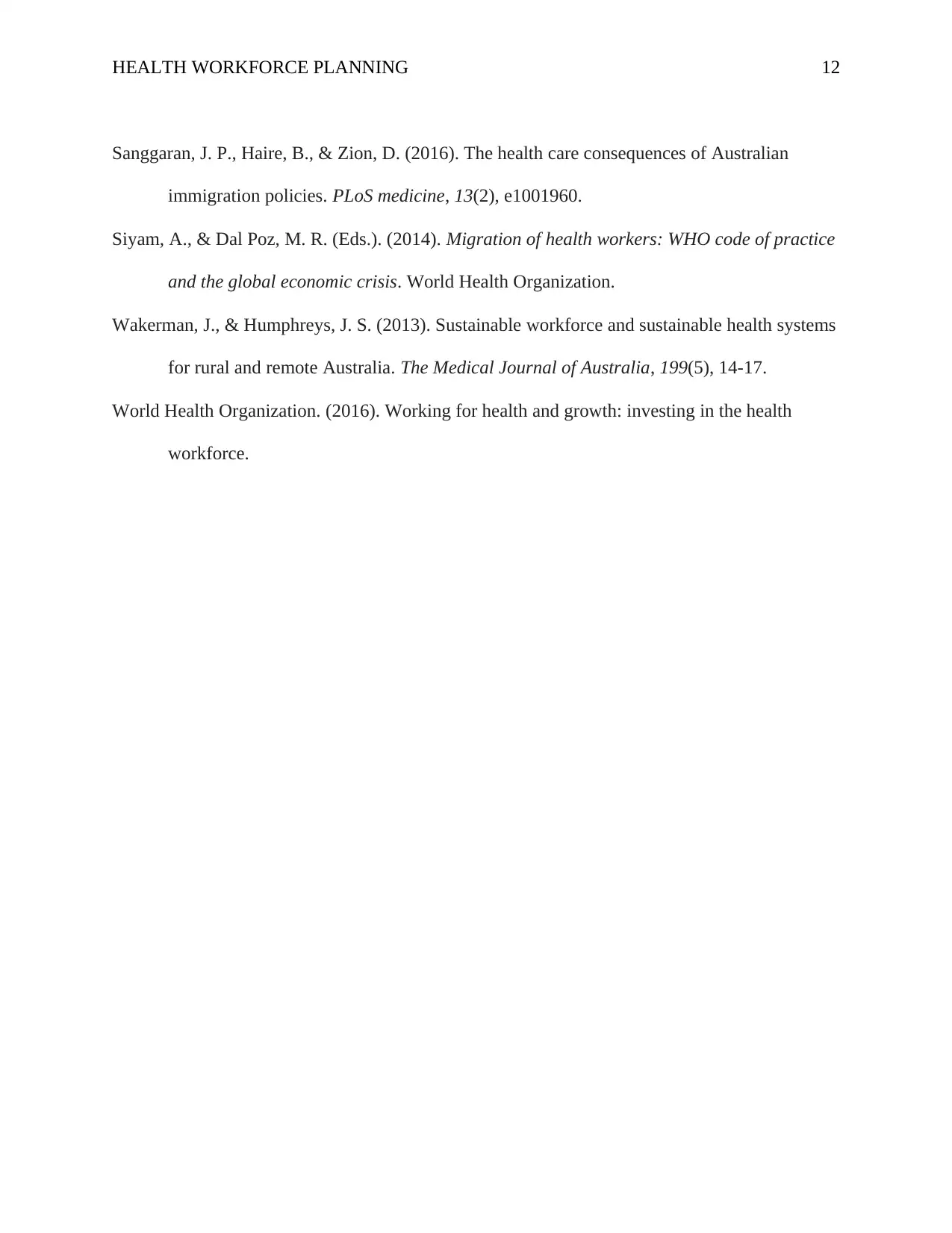
HEALTH WORKFORCE PLANNING 12
Sanggaran, J. P., Haire, B., & Zion, D. (2016). The health care consequences of Australian
immigration policies. PLoS medicine, 13(2), e1001960.
Siyam, A., & Dal Poz, M. R. (Eds.). (2014). Migration of health workers: WHO code of practice
and the global economic crisis. World Health Organization.
Wakerman, J., & Humphreys, J. S. (2013). Sustainable workforce and sustainable health systems
for rural and remote Australia. The Medical Journal of Australia, 199(5), 14-17.
World Health Organization. (2016). Working for health and growth: investing in the health
workforce.
Sanggaran, J. P., Haire, B., & Zion, D. (2016). The health care consequences of Australian
immigration policies. PLoS medicine, 13(2), e1001960.
Siyam, A., & Dal Poz, M. R. (Eds.). (2014). Migration of health workers: WHO code of practice
and the global economic crisis. World Health Organization.
Wakerman, J., & Humphreys, J. S. (2013). Sustainable workforce and sustainable health systems
for rural and remote Australia. The Medical Journal of Australia, 199(5), 14-17.
World Health Organization. (2016). Working for health and growth: investing in the health
workforce.
⊘ This is a preview!⊘
Do you want full access?
Subscribe today to unlock all pages.

Trusted by 1+ million students worldwide
1 out of 12
Related Documents
Your All-in-One AI-Powered Toolkit for Academic Success.
+13062052269
info@desklib.com
Available 24*7 on WhatsApp / Email
![[object Object]](/_next/static/media/star-bottom.7253800d.svg)
Unlock your academic potential
Copyright © 2020–2025 A2Z Services. All Rights Reserved. Developed and managed by ZUCOL.





